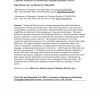Free Online Productivity Tools
i2Speak
i2Symbol
i2OCR
iTex2Img
iWeb2Print
iWeb2Shot
i2Type
iPdf2Split
iPdf2Merge
i2Bopomofo
i2Arabic
i2Style
i2Image
i2PDF
iLatex2Rtf
Sci2ools
TGIS
2002
2002
A Dynamic Architecture for Distributing Geographic Information Services
Traditional GISystems are no longer appropriate for modern distributed, heterogeneous network environments due to their closed architecture, and their lack of interoperability, reusability, and flexibility. Distributed GIServices can provide broader capabilities and functions for data management, browsing, and exchange. This paper introduces a dynamic architecture for distributing GIServices. The term dynamic indicates that the architecture is constructed temporarily by connecting or migrating geodata objects and GIS components across a network. The intention of the paper is to overview components and protocols necessary for a workable implementation of dynamically linked GIServices. The paper introduces a metadata scheme for both geodata objects and software components, and proposes an implementation framework based on existing languages, computing architectures and web services. In the framework, GIS nodes form the basic processing unit. . All GIServices can be accomplished through c...
| Added | 23 Dec 2010 |
| Updated | 23 Dec 2010 |
| Type | Journal |
| Year | 2002 |
| Where | TGIS |
| Authors | Ming-Hsiang Tsou, Barbara P. Buttenfield |
Comments (0)

